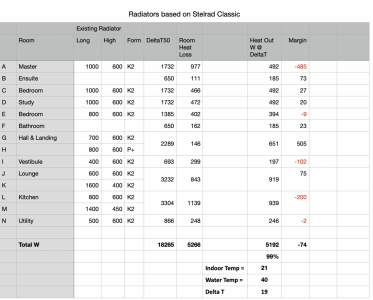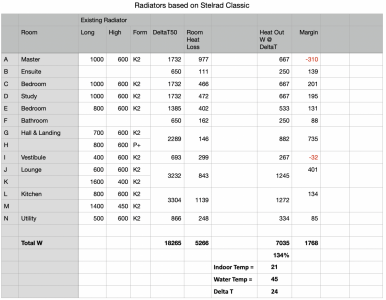Posted by: @alistairgbarron@derek-m Perhaps it’s me, now I have had a play with your spreadsheet, but if I reduce the DeltaT water temp to 30C the output falls off a cliff to 215w. Whereas according to Stelrad reducing a 2000w rad from 50C to 30C reduces it to 1030w
You are changing the water temperature to 30C, which makes the DT only 9C with an indoor air temperature of 21C.
@derek-m yes & thx.
Now I have my spread sheet of radiators calculating output of existing while I vary Delta T.
At 45C I have 134% of heat loss with 2 rads need changing 99% with at least 4 rads need changing.
The next factors will still be the 10mm tails and the buffer tank but I think I am a lot closer to that discussion now.
@transparent as I understand it (and I have yet to see it) the Daikin HP deals with the temperature of the buffer tank keeping that to the exchange temperature. Any frost is taken care of separately. Meanwhile EasyControl is made up of thermostat / motorised TRV heads. When any one of them call for heat they will open and, via an adapter/relay, switch on the DHW pump if it isn't already on. As that pump is only circulating DHW from the buffer tank it can be sized to overcome the 10mm pipes but with a spring loaded bypass for when only one or two are working.
Obviously I can juggle with programmes both for the HP and the room controls to get the temperature right and in the right places for the time of day.
Sorry to disappoint but no accent. I come from Edinburgh originally but my parents moved south when I was a bairn and I have only moved back to enjoy retirement.
@cathoderay I don't envey your difficulties, ours are nothing like that. Although it amazes me the difficulty of retrofitting to a modern property. The problem is that so much of the servicing was done to be easy for the builder and no thought was given to future access.
My preferred installer is a young company but with some bright people they are just nervous about getting their fingers burnt. Once I have quotes and the funding is in place we have plenty of time but I understand the HES are accommodating and willing to extend.
If you're going to be fitting a decent pump to push water through those 10mm rad-tails, then it's unlikely to require a bypass. Its internal pressure sensor(s) and electronics should be able to cope with modulating the speed of rotation.
Equally, you then won't need an adapter/relay system. The pump will sense the pressure-drop as a valve opens, and increase speed accordingly.
I've been running UFH manifolds like that for years, and my pump is primitive by today's standards.
BTW I like the Scottish accent for telephone calls. Maybe others think differently, but I find it really clear and easy to understand.
As for myself, I've lived on the Devon/Cornwall border for over 40-years, but have yet to sound like a stereotypical pirate. My offspring, on the other hand, were learning to roll their R's in the 1st term at school!
Save energy... recycle electrons!
@transparent I am hoping we can find a reliable pressure sensing pump although the system already has the bypass.
The Bosch EC adapter basically takes place of the boiler. It powers the head unit and where the controller would have called for heat from the boiler it closes a contact that could be used to call the DHW pump. That way the pump is definitely only running when heating is required but it would be good for it to sense the hydraulic load requirement. I take it that the set up would simply be to tell it what flow rate to achieve and let it get on with it?
Yes, my 10-year-old UFH pump had an optional wireless controller, which I didn't buy. Instead I just set the flow-rate using a pair of up/down buttons on the pump itself. There's an LED ladder alongside which shows where it is.
Modern pumps can now communicate with a Smartphone App (if you wish), and can alter the response curve in addition to the preferred max-flow.
Nor is it a market dominated by Grundfos any more. Have a look at this product-selection page from Wilo. I doubt there's many installers who've had the time to investigate all that's available.
Save energy... recycle electrons!
Posted by: @cathoderayPosted by: @transparentBut there will also be considerable time-lag before the rooms reach their set-temps.
Perhaps that's not too much of an issue. I have one section of solid concrete floor with ufh pipe buried within. That takes a good 12-hours to reach temp from 'cold'.
I wonder if this is something we don't give enough consideration to. I too have noticed my heating takes a very long time to reach temp, sometimes measured in days rather than hours, but when it gets there, it tends to hold it. I wonder if this is because it needs more heat energy the raise the temp of a structure than to keep it at the same temp? By the laws of common sense that does, err, make sense. More technically, perhaps I am getting at thermal mass, something that once warmed up holds heat. Or maybe it is latent heat. The proper terms escape me. It's all a bit like charging a battery, high charge rate to start with, trickle when fully charged. Plus a large battery will need more energy to charge it, but it will hold more energy when it is charged.
If there is anything to this, then it is another probable argument inf favour of always on systems, with the regulation done by altering LWT ie using weather comp and/or possibly flow, but on a Midea the latter is internally set.
You are indeed correct in that your home is acting as a heat store, the quantity of heat energy that is stored is often dependent upon the thermal mass of the building.
From the point of view of increasing the indoor temperature, it is once more a combination of the present heat loss, and that old favourite of our's, Delta T.
If the heat loss is say 5kWh, and the heat pump is producing 5kWh of heat energy, the system will be in balance and the indoor air temperature will remain the same. If under these conditions the indoor air temperature is 18C, and the LWT is 48C, giving a Delta T of 30C.
Raising the LWT to 50C will increase the Delta T to 32C, and may increase the heat energy output of the heat pump to 5.2kWh. The system is no longer in balance and the indoor air temperature will start to increase. But as the indoor air temperature starts to rise, the overall heat loss will also increase, which in turn will reduce the difference between the heat energy produced by the heat pump and the heat loss of the building.
If the LWT remains at 50C, the system will again balance, but at a higher indoor air temperature. The rate at which the indoor air temperature increases will be dependent upon the imbalance between the heat energy levels, and the amount of heat energy absorbed by the building fabric and internal furniture and fittings. The radiators themselves act as heat stores to an extent.
A property with a large thermal mass will therefore take longer to heat up, since it is absorbing and storing some of the excess heat energy being supplied. Conversely, a property with a large thermal mass will take longer to cool down when the heat energy supply is reduced or removed altogether. Simples. 🙂
Posted by: @alistairgbarron@transparent I expect to run the system continuously with a slightly lower night time than day. However not with a single temp thermostat for the whole building because that simply won't work. With a buffer tank the HP will maintain the tank temperature and I will use my existing EasyControl system to regulate the rooms, it will both call the DHW pump and regulate the TRVs. At a constant night/day temperatures this will maintain the balance throughout the building. Meanwhile I am hoping for a wee bit of lee way to call for a bit extra in a room when desired.
You may wish to explore the thread about 'Buffer Tanks', before you decide to have one or not.
Posted by: @alistairgbarron@transparent as I understand it (and I have yet to see it) the Daikin HP deals with the temperature of the buffer tank keeping that to the exchange temperature. Any frost is taken care of separately. Meanwhile EasyControl is made up of thermostat / motorised TRV heads. When any one of them call for heat they will open and, via an adapter/relay, switch on the DHW pump if it isn't already on. As that pump is only circulating DHW from the buffer tank it can be sized to overcome the 10mm pipes but with a spring loaded bypass for when only one or two are working.
Obviously I can juggle with programmes both for the HP and the room controls to get the temperature right and in the right places for the time of day.
Sorry to disappoint but no accent. I come from Edinburgh originally but my parents moved south when I was a bairn and I have only moved back to enjoy retirement.
The consensus of opinion is that heat pumps don't work particularly efficiently with thermostats and TRV's. There are various threads where these issues are discussed.
@derek-m Likewise a single measurement point does not work at all well in a multi room house either. Place it in the centre and the periphery will have major cold spots and place it in one of those and the centre would cook. So are we doing this for the benefit of the heat pump or the house?
I have heard and read both sides of this argument and I side with the house and control in order to get a constant temperature throughout.
Anyhow the heat pump would be working to the buffer and not the rad stats. The buffer has 2 purposes a) to help resolve the hydraulic problem of 10mm tails and b) to negate the effect of the rad valves on the heat pump.
Posted by: @alistairgbarron@derek-m Likewise a single measurement point does not work at all well in a multi room house either. Place it in the centre and the periphery will have major cold spots and place it in one of those and the centre would cook. So are we doing this for the benefit of the heat pump or the house?
I have heard and read both sides of this argument and I side with the house and control in order to get a constant temperature throughout.
Anyhow the heat pump would be working to the buffer and not the rad stats. The buffer has 2 purposes a) to help resolve the hydraulic problem of 10mm tails and b) to negate the effect of the rad valves on the heat pump.
At the end of the day it is your choice to make.
Do you have a buffer tank on your present system?
Balancing of the temperatures throughout the home would normally be done by a combination of radiator sizing and adjustment of the lockshield valves on the radiators. TRV's only being used in bedrooms.
If your system can cope at present with the gas boiler water temperature turned down and normal water pump, then it is quite possible that it will also work with the heat pump water pump, without the need for a buffer tank and additional water pump.
- 26 Forums
- 2,417 Topics
- 54.8 K Posts
- 429 Online
- 6,096 Members
Join Us!
Worth Watching
Latest Posts
-
RE: Ideal HP290 14kW ASHP - how to optimise
Thanks everyone so much for your replies and help. Last...
By cmartinbwmba , 2 minutes ago
-
RE: Recommended home battery inverters + regulatory matters - help requested
Reposted query from another thread requested by @transp...
By Sheriff Fatman , 22 minutes ago
-

RE: Sunsynk Whole House Backup Issue
@sheriff-fatman - could you please re-post that in the ...
By Transparent , 28 minutes ago
-
RE: Advice for a novice on Mitsubishi Ecodan 6kW
@robs Just to quickly fill in some of the gaps in the r...
By Sheriff Fatman , 1 hour ago
-
RE: Fan unit Making terrible noise HELP!!
@ashp-bobba The fan unit has now died. ESP says it's no...
By GutoFfowc , 1 hour ago
-
RE: Running my new Nibe ASHP efficiently
I didn't. I spent a while manually messing around with ...
By jamieheatpumpnew , 2 hours ago
-
Hi, I think I’m having some issues with my Ecodan as...
By Patch321 , 2 hours ago
-
RE: I’m glad the cold spell is over!
I comparison with the 65kWh used above yesterday was on...
By Judith , 3 hours ago
-

RE: New Daikin 11kW Altherma 3M install - is it working as it should?
@synthbuilder Further to the above…‘What a difference t...
By Toodles , 3 hours ago
-
RE: Octopus Cosy 12 Heat Pump Regret: Incredibly Loud, Poor Heating & Constant Hum - Help!
I should think so, I thought that pretty much universal...
By JamesPa , 3 hours ago
-

RE: Setback savings - fact or fiction?
I'm also inclined to look into how a defrost is actuall...
By cathodeRay , 3 hours ago
-
MLCP (Multi-Layer Composite Pipe) for ASHP
@editor nope. The info you reported was sufficient for ...
By iotum , 14 hours ago
-
RE: Experience - New Build / Complete New Heating System
@vincro I would be surprised if it is much above 5 to 6...
By ASHP-BOBBA , 15 hours ago
-
RE: Post-Traumatic Heat Pump Stress Disorder
Yes bang on and maybe I can illustrate that by way of e...
By iotum , 17 hours ago
-
-

RE: Replacing my 18 month old Hitachi Yutaki ASHP
A big thank you to @jamespa for all his efforts online ...
By trebor12345 , 20 hours ago
-

RE: GSHP WOES! Midland based engineer recommendations?
@editor It is indeed for servicing. My current service ...
By Morgan , 21 hours ago
-
RE: Speedcomfort radiator fans
In case it helps Andrew Kuhne on openenergy monitor has...
By JamesPa , 22 hours ago






